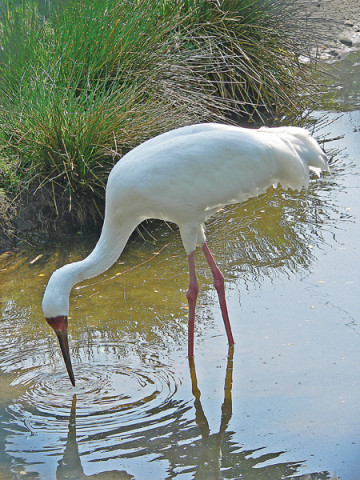
Wana Valley is really busy this time of year. It’s crane season and people from all over the country are flocking over to get their hands on the Siberian migratory birds.
This happens at least twice a year starting from December when the birds fly to the sub-continent for winter and then again towards the end of March when they are flying back home.
Unfortunately for the cranes, these months are filled with danger as poachers are ready to capture the great bird and kill it.
It starts with the crane hunters from Peshawar, Bannu, Lakki Marwat and DI Khan setting up camps or jawogara in Wana, along the border of South Wazirstan.
Crane hunting is a big sport in the area and for years the local Ahmadzai tribe has been protesting against it.
The Ahmadzai tribesmen had discussed their concerns with the political administration and other leaders, but so far nobody has done anything to stop the hunting.
A political administration official claims that every year nearly 20,000 cranes are either caught or killed in the area.
The location is ideal for the sport as there is no law to protect wild animals or birds in the region. As a result, the sport has also turned into a profitable business, where cranes can be sold. In some places, it is also the only form of entertainment for young people.
Big game hunting
According to Ehsan Wazir, the head of Waziristan Nature Conservation Organisation, in Bannu during hunting season, there is a festival on the third day of each week called Dehram Mela, where people can come to buy or sell the birds.
“Wana is turning into a place where people are hunting, bargaining, selling and buying cranes,” he said. “A crane, locally called Kagh Karkar, was bought in Wana Bazaar for Rs35,000. The bird was being sold by a truck driver from the UAE who comes here during the hunting season.”
He added that if the Dehram Mela could be held in a place like Bannu in front of the government, then it is not difficult to turn crane hunting into a profitable business in Wana where there was no law protecting the migratory birds.
One of the bloodiest scenes Wazir remembers is when he saw some cranes getting shot. “It was early morning and some of the birds had escaped, the hunters took out their Kalashnikovs and shot them on the spot.”
Crane hunter Irfan Khan says he has at least 60 cranes at home and they produce this honking kind of sound which attracts other birds too. He keeps them in a cage when he’s at the camp and while many have approached and offered him a lot of money for the birds, he vows to never sell them.
“At home we do not keep them in cages. We clip their wings so they cannot fly off and let them roam around freely,” he said. “I spend a lot of money on their food but I can’t help myself, I’m too fond of them.”
Every season there are more than a hundred camps set up in Zermilan, Spin, Tanai, Kari Kot, Dab Kot, Laman and Azam Warsak with five to 15 hunters occupying each camp.
A fare chase
While the young indulge in hunting or capturing cranes, there are some tribesmen who are against it. They claim there was no rewaj or tradition of hunting cranes in Wana. They said they love the birds and during migratory season men, women and children would gather on rooftops to look at the birds flying by. They shout out ‘zonryai zonryai kuwarai shai’ – zonryai is the Wazirwola word for cranes and kuwarai shai means to fly in a row.
To spread awareness about the campaign to protect cranes and stop crane hunting in Wana, Ehsan Wazir said he has written and distributed letters among schools and colleges to talk about the issue at their morning assemblies.
Mumtaz Dottani says he started hating the sport during one hunting season when he saw a crane fly so close to their camp that they could catch it, and when they did, he heard the bird cry. It was such a heartbreaking moment for him that he decided to give up hunting and join the campaign to protect cranes.
What is the Siberian crane
It is the only crane species with serrated edges on their beaks. The serration makes gripping slippery prey easy. They also eat roots, berries and seeds.
Published in The Express Tribune, March 22nd, 2014.












COMMENTS
Comments are moderated and generally will be posted if they are on-topic and not abusive.
For more information, please see our Comments FAQ